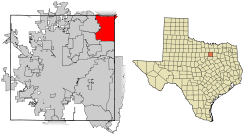Grapevine, Texas
Tarrant County
USGenWeb >> TXGenWeb >> Dallas County >> Towns & Communities >> Grapevine, Texas
 |
|
| Latitude |
32° 56' 6" N 32.935025 |
| Longitude |
97° 5' 9" W -97.085833 |
| Elevation feet/meters |
640/195 |
| Zip Code | 76051, 76092, 76099 |
| Founded | |
| GNIS FID | 1336834 |
| TXGenWeb Site | |
| Cemeteries | |
| Library | |
| Local Genealogy Society | |
| Wikipedia | |
| grapevinetexas.gov | |
In October 1843, General Sam Houston and fellow Republic of Texas Commissioners camped at Tah-Wah-Karro Creek, also known as Grape Vine Springs, to meet with leaders of 10 Indian nations. This meeting culminated in the signing of a treaty of "peace, friendship, and commerce," which opened the area for homesteaders. The settlement that emerged was named Grape Vine due to its location on the appropriately-named Grape Vine Prairie near Grape Vine Springs, both names in homage to the wild grapes that grew in the area.
|
|||||||||||||||||||||||||||||||||||||||||||||
The first recorded white settlement in what would become the modern city occurred in the late 1840s and early 1850s. General Richard Montgomery Gano owned property near Grape Vine and helped organize the early settlement against Comanche raiding parties before leading his band of volunteers to battle in the American Civil War. Growth during the 19th century was slow but steady; by 1890, Grape Vine had approximately 800 residents supported by such amenities as a newspaper, a public school, several cotton gins, a post office, and railroad service. The settlement made continued gains early in the 20th century and on January 12, 1914, the post office altered the town's name to one word: Grapevine.
.... Read More Wikipedia ....
Charles H. Young
Grapevine is near State Highway 121 some nineteen miles northeast of Fort Worth and nineteen miles northwest of Dallas in the northeastern corner of Tarrant County. The site began to be settled in the middle to late 1840s and early 1850s. In 1845 Archibald F. Leonard moved there with the "Missouri colony" from Platte County, Missouri, and by 1849 he was operating a store on his land. The store was on the southwest corner of his survey, near where the town square was later built; it was also at the site where the restored Torian log cabin, which predated the town, stands today. Over the years the community has been known by a variety of names, including Cross Timbers (1846 to 1851), Grape Vine Springs, Leonardville, Dunnville, Grape Vine, and Grapevine. In 1846 Lonesome Dove Baptist Church was established at the settlement. About 1854 James Tracy Morehead, A. F. Leonard, Henry Suggs, and others met to lay out the town and arrange for a post office. Judge Morehead suggested the name Grape Vine for the town, as it was located on the edge of the Grape Vine Prairie, which in turn had taken its name from the Grape Vine Springs. The name probably referred to the numerous wild grapes that grew in the vicinity; there was also a nearby Grapevine Creek. About 1856 Eli Mathis Jenkins, then living at Jefferson, Texas, sent a stock of merchandise and opened a new store in Grape Vine, employing Irenius Plato Solon Dunn to manage it. The post office was then moved to Jenkins's store, and Solon Dunn was appointed postmaster on August 4, 1858. People began calling it Dunn's store, and some called the community Dunnville for a time, but the post office has never been known by any other name than Grape Vine or Grapevine. In 1866 a Masonic lodge (Grapevine Lodge No. 288) was established, and Joseph Dunn served as its first worshipful master. A school, Grapevine Masonic Institute, operated at the community from 1869 to 1886. By 1890 the town had 800 residents, four churches, three gristmills and cotton gins, and a public school. A newspaper, the Grapevine Sun, began publishing in the 1890s, and by around 1900 the St. Louis Southwestern Railway was running through the town. On January 12, 1914, the post office officially changed the spelling of its name to one word, Grapevine. That year the town had 1,200 residents and numerous businesses, including grocers, banks, and hotels. By 1925, however, its population had dropped to 821. In 1940 it had a population of 1,043, with seventy rated businesses. The town had incorporated by 1936. The Dallas-Fort Worth International Airport opened in 1974 at the southeastern limits of the city. Because of its proximity to the airport and the major metropolitan areas of Dallas and Fort Worth, Grapevine grew considerably in the latter half of the twentieth century. In 1960 its population was 2,821; in 1970, 7,023; and in 1980, 11,801. By 1990 Grapevine had 29,202 residents. In the early 1990s Grapevine included a historical museum, which was housed in a restored railroad depot, and the Grapevine Opry, which showcased country music entertainment. Near the town was Grapevine Lake, a major recreational center. By 2000 the population reached 42,059.
BIBLIOGRAPHY: Weechie Yates Estill, Grapevine Recollections (Bedford, Texas, 1965). Grapevine Lodge No. 288, A.F. & A.M., Grapevine Lodge History, by the late Zebulon Jenkins (Fort Worth: Masonic Home and School of Texas, 1934). Vertical Files, Dolph Briscoe Center for American History, University of Texas at Austin. Charles H. Young, ed., Grapevine Area History (Grapevine, Texas, Historical Society, 1979).
Handbook of Texas Online, Charles H. Young, "GRAPEVINE, TX (TARRANT COUNTY)"
.... Read More TSHA ....




